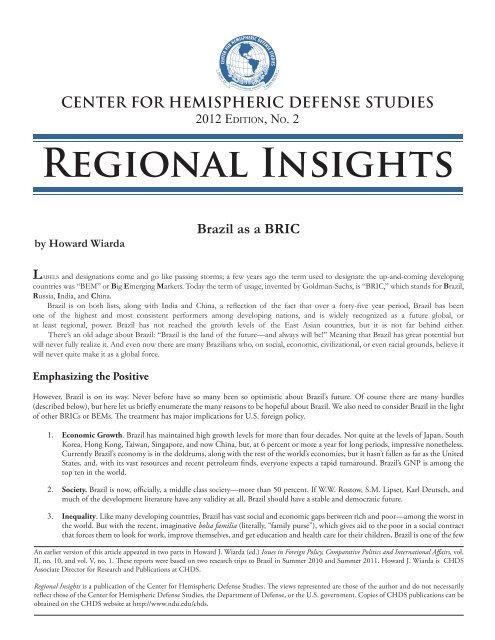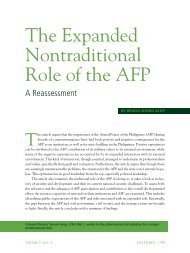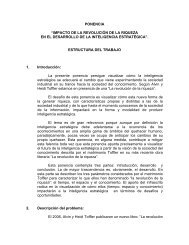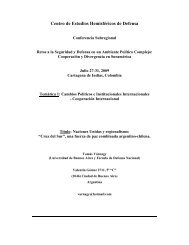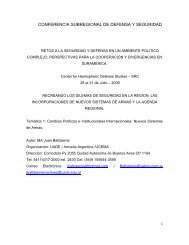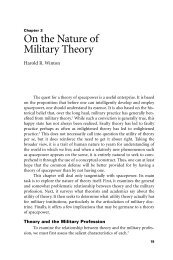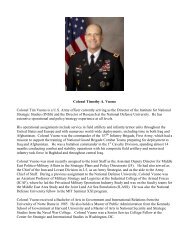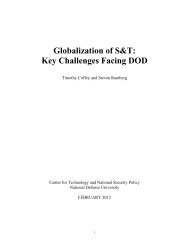Regional Insights - National Defense University
Regional Insights - National Defense University
Regional Insights - National Defense University
You also want an ePaper? Increase the reach of your titles
YUMPU automatically turns print PDFs into web optimized ePapers that Google loves.
CENTER FOR HEMISPHERIC DEFENSE STUDIES<br />
2012 Edition, no. 2<br />
<strong>Regional</strong> <strong>Insights</strong><br />
by Howard Wiarda<br />
Labels and designations come and go like passing storms; a few years ago the term used to designate the up-and-coming developing<br />
countries was “BEM” or Big Emerging Markets. Today the term of usage, invented by Goldman-Sachs, is “BRIC,” which stands for Brazil,<br />
Russia, India, and China.<br />
Brazil is on both lists, along with India and China, a reflection of the fact that over a forty-five year period, Brazil has been<br />
one of the highest and most consistent performers among developing nations, and is widely recognized as a future global, or<br />
at least regional, power. Brazil has not reached the growth levels of the East Asian countries, but it is not far behind either.<br />
There’s an old adage about Brazil: “Brazil is the land of the future—and always will be!” Meaning that Brazil has great potential but<br />
will never fully realize it. And even now there are many Brazilians who, on social, economic, civilizational, or even racial grounds, believe it<br />
will never quite make it as a global force.<br />
Emphasizing the Positive<br />
Brazil as a BRIC<br />
However, Brazil is on its way. Never before have so many been so optimistic about Brazil’s future. Of course there are many hurdles<br />
(described below), but here let us briefly enumerate the many reasons to be hopeful about Brazil. We also need to consider Brazil in the light<br />
of other BRICs or BEMs. The treatment has major implications for U.S. foreign policy.<br />
1. Economic Growth. Brazil has maintained high growth levels for more than four decades. Not quite at the levels of Japan, South<br />
Korea, Hong Kong, Taiwan, Singapore, and now China, but, at 6 percent or more a year for long periods, impressive nonetheless.<br />
Currently Brazil’s economy is in the doldrums, along with the rest of the world’s economies, but it hasn’t fallen as far as the United<br />
States, and, with its vast resources and recent petroleum finds, everyone expects a rapid turnaround. Brazil’s GNP is among the<br />
top ten in the world.<br />
2. Society. Brazil is now, officially, a middle class society—more than 50 percent. If W.W. Rostow, S.M. Lipset, Karl Deutsch, and<br />
much of the development literature have any validity at all, Brazil should have a stable and democratic future.<br />
3. Inequality. Like many developing countries, Brazil has vast social and economic gaps between rich and poor—among the worst in<br />
the world. But with the recent, imaginative bolsa familia (literally, “family purse”), which gives aid to the poor in a social contract<br />
that forces them to look for work, improve themselves, and get education and health care for their children, Brazil is one of the few<br />
An earlier version of this article appeared in two parts in Howard J. Wiarda (ed.) Issues in Foreign Policy, Comparative Politics and International Affairs, vol.<br />
II, no. 10, and vol. V, no. 1. These reports were based on two research trips to Brazil in Summer 2010 and Summer 2011. Howard J. Wiarda is CHDS<br />
Associate Director for Research and Publications at CHDS.<br />
<strong>Regional</strong> <strong>Insights</strong> is a publication of the Center for Hemispheric <strong>Defense</strong> Studies. The views represented are those of the author and do not necessarily<br />
reflect those of the Center for Hemispheric <strong>Defense</strong> Studies, the Department of <strong>Defense</strong>, or the U.S. government. Copies of CHDS publications can be<br />
obtained on the CHDS website at http://www.ndu.edu/chds.
emerging countries that is actually reducing poverty—<br />
now at only 20 percent.<br />
4. Politically. Brazil has now had two good presidents in a<br />
row, world-class sociologist Fernando Henrique Cardoso<br />
and labor leader Luiz Inacio (Lula) da Silva. And a third,<br />
Dilma Rousseff, about whom it is still too early to judge.<br />
Both previous presidents served two terms of four years<br />
each, making a total of sixteen years of democratic stability.<br />
If democracy and stability are among the prerequisites<br />
of growth, then Brazil is on its way.<br />
5. Resources. Brazil has vast mineral wealth, rich agriculture<br />
comparable to the Argentine pampa or the American<br />
Midwest (it has already surpassed the United States<br />
in the production of soybeans), and now vast oil and<br />
natural gas resources. When oil again reaches $130 a gallon,<br />
it will be feasible for Brazil to tap these reserves and<br />
become a world power.<br />
6. Brazilian national self-confidence is on the rise.<br />
Whether in soccer, music, or world-class models (think<br />
of Giselle Bündchen), Brazil now is among the globe’s<br />
leaders. Brazilian nationalism, always strong, now has<br />
numerous successes on which to build. Not only does<br />
this provide national consensus and the “glue” that holds<br />
society together, but it also energizes government policy<br />
in the education and other social fields. The sense is<br />
strong that, as the billboards throughout the country put<br />
it, “Nothing can hold Brazil back.”<br />
7. Brazil’s foreign policy has shown remarkable success in<br />
recent decades. Brazil is now the unquestioned leader in<br />
South America, the main motor force in MERCOSUR<br />
and other regional bodies, the chief force in Haitian<br />
peacekeeping, and a major player in Third World councils.<br />
Brazil’s diplomatic triumphs have been mainly quiet<br />
and are all but completely ignored and unknown in the<br />
United States. But one of these days we will wake up and<br />
discover Brazil has triumphed in its quest for a seat on<br />
the Security Council and/or has supplanted the United<br />
States in the OAS.<br />
8. Brazil is committed to genuine national development.<br />
Development is no longer limited to the “strategic triangle”<br />
of São Paulo, Belo Horizonte, and Rio de Janeiro,<br />
but has become a national preoccupation, encompassing<br />
the Northeast, the vast Amazon basin, the West, and<br />
the South. Brazil is filling both its geographic and its<br />
institutional and associational space. There have been<br />
vast increases not only in Brazil’s traditional mineral and<br />
agricultural exports but in its manufacturing and high<br />
tech (computers, biotech, military equipment) as well.<br />
9. Brazilians are taller, more literate, and healthier than ever<br />
before. Many Brazilian men in the past wore elevator<br />
shoes; now that is no longer necessary. It’s amazing, over<br />
forty years, what better nutrition and health care can do.<br />
10. Educationally, Brazil is in the process of changing, at<br />
secondary and university levels, from a humanistic tradition—letters,<br />
law, literature, theology—to a more sci-<br />
REGIONAL INSIGHTS<br />
2<br />
entific orientation: science, math, computers, statistics,<br />
engineering, biology, chemistry. The government is leading<br />
this change, pouring funds for scholarships, labs, and<br />
faculty into new universities such as UNICAMP, whose<br />
student body is now half graduate students. It’s interesting<br />
that the United States is producing ever more lawyers,<br />
while Brazil—reversing the course of the last two<br />
centuries—is producing more engineers.<br />
11. Brazil is rapidly building infrastructure—one of the key<br />
ingredients for any development project: dams, highways,<br />
bridges, farm-to-market roads, power stations,<br />
electrical grids. The number and movement of trucks on<br />
Brazil’s highways are now, at least visually, as great as that<br />
of the United States. Brazil is clearly on the move, no<br />
longer a “sleeping giant.” The best of these highways, in a<br />
country that has long depended on the state for development,<br />
are now privatized and at still-low rates.<br />
12. There is dynamism, movimento, in Brazilian society that<br />
is currently lacking in the United States. Construction<br />
cranes are everywhere, and whole new cities are springing<br />
up on the outskirts to provide cheap labor to Brazil’s<br />
industries. People are in a hurry and they work hard;<br />
the older, “sleepier,” more fatalistic Brazil is becoming<br />
a thing of the past. Max Weber’s “Protestant Ethic and<br />
the Spirit of Capitalism” is alive and well in historically<br />
Catholic Brazil.<br />
13. At the same time, attention to politics has significantly<br />
declined. It is economics—jobs, business, investment,<br />
trade, development—that drives Brazil now, not politics.<br />
Brazil is not apolitical, but certainly since the early 1960s<br />
there has been a sharp decline in political activity and<br />
ideology, as in Spain or Italy. “Development” is the new<br />
and even official ideology of Brazil. There is almost no<br />
threat of political or economic instability, or of extraconstitutional<br />
threats from right or left.<br />
An interesting exercise is to compare Brazil with other members<br />
of the BRIC class. India and China both have a billion people and<br />
are countries that are developing rapidly, especially China. China,<br />
India, and Russia all have nuclear weapons, abundant resources,<br />
and are, or will be, global powers.<br />
On the other hand and unlike one or more of the other<br />
BRIC members, Brazil has no deserts, it has abundant land that is<br />
productive all year round, and has no problems of overpopulation.<br />
It has settled borders on all sides, no unintegrated minorities or<br />
separatist movements within its territory, and a proud tradition<br />
that gives it national unity. It has, like the other BRICs, vast<br />
resources that it is today exporting, especially to China, which (a<br />
little-known fact) has replaced the United States as Brazil’s largest<br />
trading partner. And now with its vast petroleum discoveries,<br />
Brazil has in future decades the potential to become both a<br />
developed nation and one of the world’s great powers. It is both<br />
an awesome and inspiring moment for Brazil.<br />
All the BRICs are important, of course. And U.S. foreign policy<br />
needs to adjust accordingly to the new significance and influence<br />
of the emerging BRICs. But in this constellation, we would not<br />
bet against Brazil. These factors make Brazil look awfully positive<br />
at present. Of course the negatives are also powerful.
Brazil is still, in many respects, a developing country. Or, if not<br />
Third World, at best Second World, in the same sense that Poland,<br />
Mexico, much of Eastern Europe, Malaysia, and South Africa are<br />
still Second World. This doesn’t mean “Second World” in the oldfashioned<br />
ideological sense of “developed” communist countries;<br />
but in the newer sense of countries between the First and Third<br />
worlds, in intermediary positions, having made a breakthrough<br />
to modern, developed status, but still inefficient, disorganized,<br />
and with large sectors of the population not yet benefitting from<br />
globalization and modernization. And this Second World status<br />
may be long-term, quasi-permanent, lasting 50–100 years. For<br />
Brazil as well as the others, there is no magic formula, no instant<br />
breakthrough; instead, development is a long, hard slog.<br />
Chile is the only country in Latin America so far to have<br />
made the breakthrough to what the World Bank calls “advanced<br />
market economies.” And even Chile has a very long way to go to<br />
achieve modern or First World status. We sorely need a new set of<br />
categories, like my revised “Second World” designation above, to<br />
describe these countries like Brazil that have made a breakthrough<br />
but still have a long way to go.<br />
Brazil as Second World<br />
There is no doubt that Brazil has made great strides in recent<br />
decades. Over a fifty-year period since the 1960s, Brazil has<br />
clearly moved from Third to Second World status. But it still has<br />
a considerable distance to travel to achieve both First World rank<br />
and the global respect to which Brazil aspires. Indeed it is one<br />
of our “Second World” characteristics that Brazil may be semipermanently<br />
locked into that category.<br />
What’s wrong? Where does Brazil go astray? Can it be<br />
permanently “stuck” in a Second World position?<br />
Actually, Brazil is, like all societies, a very complex country.<br />
There are layers upon layers; like an onion, it’s necessary to peel<br />
back all the layers. Modernity and tradition continue to exist side<br />
by side, even within the same individual; it’s only the proportion<br />
that changes slightly over time. And that’s basically what we mean<br />
by “modernization.”<br />
In Brazil’s case, because it’s so large and complex, its problems<br />
are also complex. Let us enumerate the ways:<br />
1. Education. Brazil has, for a modernizing country, one<br />
of the world’s worst public education systems. Its schools<br />
are not preparing its youth to function in the modern<br />
world. Illiteracy is still 20–30 percent, technical schools<br />
are few, and no self-respecting middle class family would<br />
ever send their children to the woeful public schools.<br />
Jewish and Protestant families in Brazil frequently send<br />
their children to Catholic, often Jesuit, schools, not because<br />
they’re converting but because those are the best<br />
schools.<br />
2. Universities. The same criticisms apply. The <strong>University</strong><br />
of São Paulo likes to boast that it is the “Harvard” of<br />
Brazil or maybe all of South America. But it is not up to<br />
the level of a Big Ten, SEC, or other good state university.<br />
The <strong>University</strong> is highly politicized, it seems to be<br />
“always” on strike, it has too many unqualified students,<br />
and the faculty clings to outmoded ideas (Marxism,<br />
REGIONAL INSIGHTS<br />
3<br />
Trotskyitism, dependency theory) of 30–40 years ago.<br />
The <strong>University</strong> of Brasilia is even worse, captured by the<br />
left wing of the Labor Party and enforcing that ideology<br />
on the students and faculty. Of Brazilian universities,<br />
only Campinas has made the breakthrough to a modern,<br />
more science- and research-oriented, graduate-level<br />
university.<br />
3. For lack of funds, the internal Brazilian road system is<br />
terrible, holding back an otherwise booming and dynamic<br />
economy. The only good roads, such as the sixlane<br />
highway between São Paulo and Campinas, are<br />
private.<br />
4. Brazilian public health care, state run, is better than a<br />
half century ago but still woefully inadequate. Facilities<br />
are often crowded and dirty, doctors are underpaid, and<br />
the equipment and facilities are old and inadequate. At<br />
the same time, as with education, private facilities and<br />
care are often excellent if you can afford them, and in<br />
specialized centers Brazil is doing pioneer work.<br />
5. Corruption in Brazil is exploding. At all levels: local,<br />
state, federal. There is so much investment money flowing<br />
into Brazil these days that its banks and investment<br />
houses don’t know what to do with it all, let alone control<br />
it. The local, two-man versions of ipad and Twitter<br />
are flooded with American and other hedge fund and<br />
pension money. With so much money around, how<br />
could anyone resist skimming off a little for oneself? The<br />
skim-off rate is currently at about 30 percent. Brazilian<br />
lawyers talk of jeito (“grease,” used to “oil” the wheels of<br />
government) in the following three categories: there is<br />
honest jeito (a little patronage applied here and there to<br />
get things done), dishonest jeito (outright bribery), and<br />
then a vast area in between where the lawyers make all<br />
their money!<br />
6. Incompetence still prevails at many levels: airports, immigration,<br />
police, courts, government, water, electricity,<br />
municipal services, bureaucracy, local and state governments.<br />
If we think we have “broken government” (the<br />
title of a recent book on American foreign policy) in the<br />
U.S., go to Brazil or India to see real dysfunction.<br />
7. Crime, violence, and armed robberies in Brazil have<br />
reached some truly mind-numbing levels. Every selfrespecting<br />
hotel, apartment residence, or store (loja) has<br />
security, often platoons of it. On Copacabana, there is an<br />
average of 12 police per block; every Brazilian has a story,<br />
often several of them, of how they were robbed, ripped<br />
off, or suffered an armed home invasion or kidnapping.<br />
Brazil is becoming like South Africa, where personal,<br />
home, and business security is the fastest growing sector<br />
of the economy<br />
8. Social inequality. Through the lauded Bolsa Familia<br />
program, which provides social assistance to poor families<br />
in return for promises by the recipients to send their<br />
children to school and to improve their own lives, Brazil<br />
has been reducing poverty. But figures have shown<br />
that 90 percent of Brazilians are not benefitting from
the country’s recent globalization and development.<br />
A visit to one of Brazil’s fancy new malls, such as<br />
the Parque Dom Pedro in Campinas, shows that there<br />
are two, three, and more Brazils: a First World Brazil of<br />
big spenders and the good life, who are mainly white,<br />
and a Third World Brazil of workers who do hard labor<br />
and are much darker, with of course many gradations<br />
in between. Unless Brazil (and other Latin American<br />
countries, including Chile) reduce their social gaps and<br />
incorporate the poorer classes into the national society<br />
and economy, they will always remain poor and Second<br />
or Third World.<br />
9. The Brazilian economy has performed at miracle rates<br />
lately, mainly based on the demand for commodities<br />
and other exports. Foreign capital is pouring into the<br />
country, faster than Brazil can absorb it. As a result, not<br />
just corruption but also inflation is rising, and many<br />
fear Brazil is becoming a bubble economy akin to the<br />
U.S. housing market. The flood of money has reinforced<br />
Brazil’s preference for economic statism and made it appear<br />
as if no reforms of the Brazilian (Lulista) model are<br />
needed. Actually, the Brazilian system requires strong<br />
structural reform if it is to continue at high growth rates.<br />
10. At the political level there are many problems. President<br />
Dilma Rousseff has nowhere near the political and administrative<br />
skills that her predecessors did. Sixteen years<br />
of (relatively) good governments under Fernando Henrique<br />
Cardoso and then, surprisingly, Lula made it appear<br />
that Brazil was solidly in the stable-democratic category.<br />
But Dilma’s relations with the Congress are bad, she cannot<br />
manage her own coalition or cabinet, corruption is<br />
flourishing, and the political system is fragmenting. Brazilians<br />
think that Dilma is only warming the presidential<br />
chair until Lula can return in 2014; meanwhile she<br />
is surrounded by too many thieves and thugs left over<br />
from the previous Partido Trabalhista administration.<br />
Looking closely at Brazil leaves one quite shaken, despite<br />
the continued economic growth. Politically, there<br />
is a sense of considerable uncertainty, loose ends, things<br />
unraveling and pulling apart. It is reminiscent of the unstable<br />
period in the late 1980s–1990s—during the time<br />
of Tancredo Neves, Itamar Franco (who just died recently),<br />
Fernando Collor (impeached), and José Sarney—<br />
when the new Brazilian democracy hung by a thread and<br />
almost collapsed. Now too, without being alarmist about<br />
it, there is the sense that Brazilian democracy is considerably<br />
less institutionalized than we think it is.<br />
11. Foreign policy. Brazilian foreign policy, under former<br />
ambassador to the U.S. Antonio Patriota, is far more assertive,<br />
aggressive, and independent than it once was. In<br />
Africa, the Middle East, Europe, Asia, and the Americas,<br />
Brazil is doing things diplomatically it never would have<br />
done in past decades. Not only is Brazilian foreign policy<br />
more independent of the United States, but there are<br />
many in Brazil, including Itamaraty, the foreign ministry,<br />
who not-so-secretly hope that the United States fails.<br />
This is a very dangerous mood and calls for some strong<br />
fence-mending on the part of the United States.<br />
REGIONAL INSIGHTS<br />
4<br />
12. Brazilian soccer is the pride of the country, closely tied<br />
up with Brazilian nationalism and, to a large extent, replacing<br />
Catholicism as the national religion. But today’s<br />
Brazilian team (the Selecão) is troubled: not executing<br />
well, sleep-walking through its matches, full of self<br />
doubts, and recently losing to Paraguay. The players are<br />
pampered and overpaid, they don’t work very hard at<br />
practice sessions, and there is a severe generation gap<br />
between the older players who are dedicated and the<br />
younger guys who self-interestedly see their futures not<br />
so much with the national team as with the club teams<br />
who pay them. Some say, “As Brazilian soccer goes, so<br />
goes the country.”<br />
Whither Brazil?<br />
There is no doubt that Brazil is booming ahead economically and<br />
is quite a changed society from the “sleepy,” Catholic, conservative,<br />
Third World country of fifty years ago. There is an energy here<br />
and a dynamism, an optimism about the future, that is lacking in<br />
many already-developed countries, including the United States.<br />
The problem is that this development is so uneven. Economic<br />
development, cultural change, and social modernization are<br />
proceeding much faster than political or institutional development,<br />
First World Brazil (São Paulo, Campinas, some other enclaves) is<br />
developing far faster than Third World Brazil (the Northeast, the<br />
West, the Amazon basin), and the already-wealthy are getting far<br />
wealthier while the poor lag ever-farther behind.<br />
Brazil’s private sector is efficient, modern, and globalized, while<br />
the public sector, though formally democratic, is often inefficient,<br />
patronage-dominated, corrupt, and downright dysfunctional.<br />
Although they cannot say this publicly, businessmen in the São<br />
Paulo private sector despise the politicians in Brasilia and at the<br />
state and local levels, tell demeaning jokes about them, and carry<br />
out their private business almost as if the government didn’t exist.<br />
That old adage still rings true that “Brazil develops at night while<br />
the government sleeps.”<br />
At the international level, Brazil is an emerging power, like<br />
China, India, or South Korea. It will no longer do to ignore Brazil,<br />
treat it with indifference, or, worse, insult and slight Brazil. It is<br />
long past due for us to put our relations with Brazil on the same<br />
stable, mature, partnership basis that we maintain with other<br />
leading countries. n<br />
The Center for Hemispheric <strong>Defense</strong> Studies (CHDS), established by the United<br />
States Congress in 1997, is a Department of <strong>Defense</strong> regional studies institute<br />
that uses applied policy educational and research for the strategic-level<br />
promotion of effective security policies within the democracies of the Western<br />
Hemisphere. Its civilian, military and security force graduates and partner<br />
institutions comprise communities of mutual interest and support that work<br />
toward a more cooperative and stable international security environment. In<br />
carrying out its work, CHDS supports SOUTHCOM and NORTHCOM,<br />
the <strong>National</strong> <strong>Defense</strong> <strong>University</strong> and the Office of the Secretary of <strong>Defense</strong>.<br />
The CHDS vision is to remain the pre-eminent institution for teaching, research<br />
and outreach on defense and security issues affecting the Americas.<br />
CHDS Director: Dr. Richard D. Downie<br />
Managing Editor: Yamile Kahn<br />
Assistant Editor: Patricia Kehoe<br />
Graphic Design: Vivian Rodriguez


